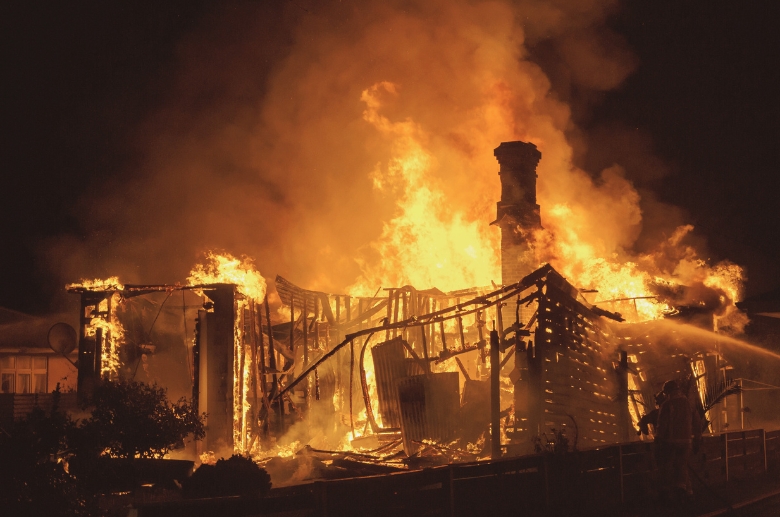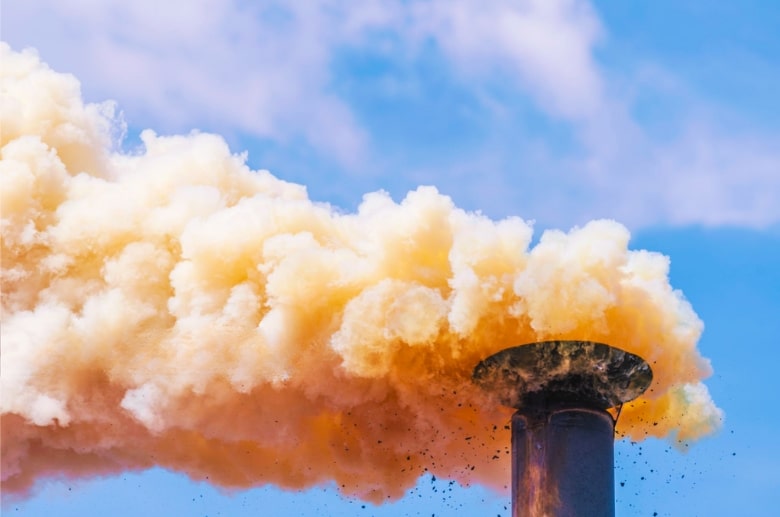Chimney caps serve as invaluable protectors for homes equipped with fireplaces or wood-burning stoves. They shield against rain, debris, and unwanted critters while acting as barriers against hazardous sparks.

Yet, if you notice your chimney cap glowing red, it’s crucial to determine the reasons, understand the associated dangers, and explore potential solutions. We created this guide to help you deal with this concerning issue by addressing what steps to take when your chimney cap shows a red glow.
——
Do You Need to Hire Chimney & Fireplace Expert?
Get free quotes from qualified experts near you. No commitment required!
——
Causes of Why Your Chimney Cap Glowing Red
A glowing chimney cap can be attributed to various causes, each posing potential risks.
- Overheating: An excessively active fireplace or stove can lead to the chimney cap absorbing excessive heat, resulting in a vivid red glow.
- Trapped Embers: Erratic drafts can trap embers within the cap, causing an unsettling radiance.
- Creosote Buildup: The accumulation of creosote, a flammable substance, and other debris inside the chimney can ignite, contributing to the cap’s glow.
- Flawed Installation or Damage: Compromised integrity due to flawed installation or damage to the chimney cap itself can make it susceptible to overheating.
- Excessive Use: Relentless use of a fireplace or stove can elevate temperatures to the point of a glowing chimney cap.
Dangers of a Glowing Red Chimney Cap
Seeing your chimney cap glow red isn’t just a visual spectacle; it signifies potential hazards.

The most immediate risk is the possibility of a chimney or house fire. When a chimney cap glows red, it often indicates excessive heat, which can ignite nearby combustible materials. This ignition can lead to a devastating fire within your home, endangering lives and property.
Additionally, the intense heat generated by this phenomenon can result in structural damage to the chimney itself. The intense heat from a glowing chimney cap can harm the chimney’s structure, causing mortar and brick degradation and compromising stability.
Cracks may form, letting in moisture and worsening structural problems. In severe cases, metal components, like the flue liner, could warp, demanding expensive repairs or chimney replacement.
Furthermore, the heat and smoke produced during this event can lead to health risks. Smoke exposure can cause respiratory issues, and the presence of carbon monoxide, a colorless, odorless gas, poses severe health hazards, including carbon monoxide poisoning.
Signs of a Glowing Chimney Cap
Quickly noticing the signs of a glowing chimney cap is crucial. Here are the typical indicators:

- Bright Glow from Chimney Cap: A red, orange, or yellow glow indicates overheating, requiring urgent attention.
- Strong odor coming from the chimney: Another unmistakable sign is the presence of a strong, often pungent odor coming from the chimney. This odor results from excessive heat and burning materials within the chimney, emphasizing the pressing need to address the situation.
- Loud popping or cracking noises and visible smoke or flames. Listen for loud popping or cracking noises emanating from the chimney area. These sounds, coupled with visible smoke or flames escaping from the chimney, are clear indicators of a chimney cap issue. According to a study, 86% of wood heat-related fires originate in the chimney or stove pipe when creosote ignites. A single spark can ignite if the stove or chimney temperature is high enough.
When you witness these signs, it’s critical to take immediate action to prevent potential hazards such as fires, structural damage, or health risks.
What to Do If You See a Glowing Chimney Cap
If you ever spot your chimney cap glowing red, act promptly to prevent potential hazards. Here are the immediate actions you should take:
Step 1: Stop Using the Fireplace or Stove: The first step is to cease using your fireplace or stove immediately. Allowing it to cool down is vital to reduce the fire risk and further damage.
Step 2: Contact a Professional Chimney Sweep: Get in touch with a certified chimney sweep without delay. They have the expertise to inspect and clean chimneys effectively and can pinpoint and address the cause of the glowing cap.
Step 3: Look for Other Signs of a Chimney Fire: As you wait for the chimney sweep, watch for other chimney fire signs like loud cracking sounds, popping noises, dense smoke, or visible flames. If these signs appear, call the fire department immediately.
——
Do You Need to Hire Chimney & Fireplace Expert?
Get free quotes from qualified experts near you. No commitment required!
——
How to Prevent a Glowing Chimney Cap
Here are some key steps to ensure your chimney cap remains in good condition:

1. Annual Chimney Inspections and Regular Cleaning
Scheduling annual inspections of your chimney is crucial for early detection of potential issues that could lead to a glowing cap. Regular cleaning combined with these inspections can effectively prevent the accumulation of creosote and other debris, averting more severe problems.
2. Correct Installation and Maintenance of the Chimney Cap
Ensure your chimney cap is correctly installed, and any existing damage or issues are promptly addressed. Seek for chimney caps that securely screw onto your roof for optimal safety. Additionally, if your chimney is unused, consider capping it, as this can prevent debris accumulation and reduce maintenance needs.
Caps that simply slide into the flue may slide out, particularly during strong winds, leading to potential damages to your property or neighboring areas and increased risks during tornadoes.
3. Appropriate Use of Fireplace or Stove
Follow the manufacturer’s instructions and safety recommendations when using your fireplace or stove. Avoid using too much fuel, which can cause overheating and lead to a glowing cap.
During use, stick to the recommended fuel type, typically seasoned wood, and avoid burning wood or other materials in appliances not designed for them. Also, ensure the area around the fireplace is free from flammable materials and supervise children and pets while the fireplace or stove is in use.
4. Use of Creosote Remover
To reduce creosote accumulation in chimneys, consider using creosote removers.
These removers are engineered to reduce chimney fire hazards by modifying the composition of dense or advanced-stage creosote, thus facilitating its removal during chimney cleaning.
Specifically, they function by counteracting creosote’s slight acidity, making it less damaging to metal parts and reducing its flammability. Additionally, they work by absorbing oils and moisture in certain types of creosote, drying it out, and acting as a combustion barrier.
Further enhancing their effectiveness, Some removers include a magnesium catalyst, helping to break down tough advanced-stage creosote as the chimney heats up, converting it into a substance that’s easier to handle. Regular use of these products can significantly aid in preventing issues like glowing chimney caps and enhance the safety of your home and family.
Conclusion
A glowing chimney cap isn’t just an unusual sight. It poses serious risks, from fires to structural damage. Regular inspections, annual cleanings, and proper chimney cap installation are crucial. Moreover, follow usage recommendations and use creosote inhibitors to ensure a safe fireplace experience.
Act now to protect your home. Don’t wait. Contact a professional chimney sweep if you suspect issues to safeguard your home and loved ones.






